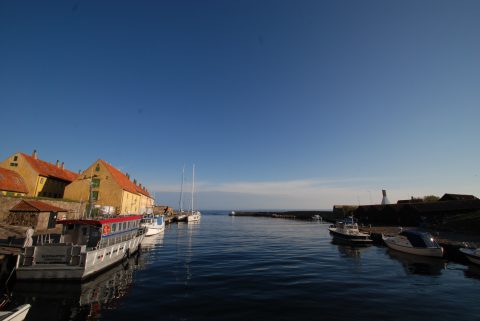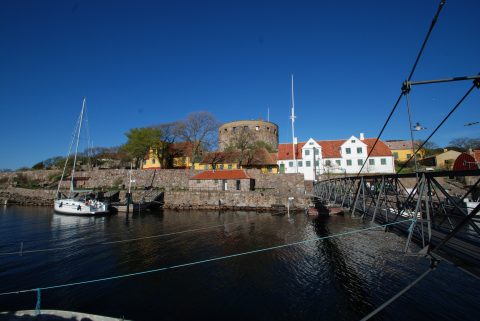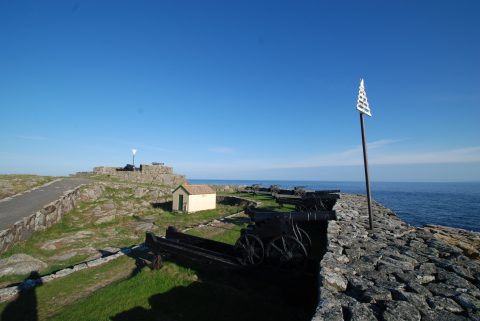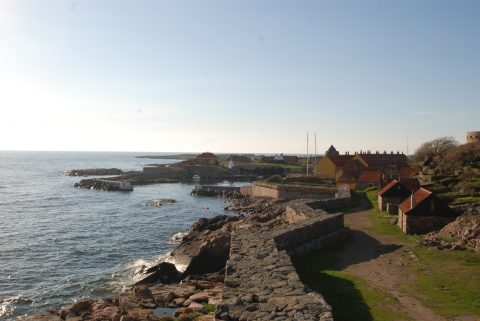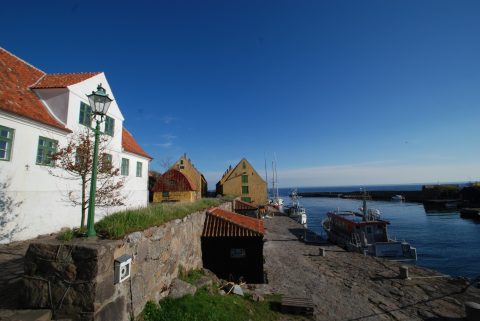Denmark
Cruising grounds
The country
Linking Central Europe to Scandinavia, the Kingdom of Denmark offers rich and varied landscapes, beautiful beaches and romantic towns with good shopping facilities. Over 7,000km of coastline, many fjords and numerous islands make Denmark a highly attractive cruising ground for leisure boaters. More than 500 places to berth – from small fishing harbours to modern marinas – cater to the most diverse needs.
Cruising grounds
The Little Belt is the westernmost connection between the Kattegat and the Baltic Sea. At its narrowest point near Middelfart, it is only approx. 100m wide. To the South, the Little Belt opens up into the “Danish South Sea”, one of the most fascinating cruising grounds of the Baltic Sea. Precise navigation is absolutely indispensable between the islands of the Danish South Sea.
Since the Storebælt bridge connecting the islands of Fyn and Sjælland was opened in 1998, ferry traffic through the Great Belt (Storebælt) has decreased, much to the delight of leisure boaters. A precise look at the nautical chart is an absolute must here to avoid running aground on one of the sprawling reefs or a shoal. It is also very important to mind the sometimes strong current. In many charts, the Great Belt also includes the Langelandsbelt which is located to the south between the island Langeland to the west and Lolland to the east.
The Smaalands fairway extends east of the Great Belt and south of the island of Sjælland. In this cruising ground, skippers need to watch out for currents and always keep to the fairway.
Øresund is the most frequented connecting route between the Baltic Sea and the Kattegat. The Øresund Bridge connects the two largest cities on the Sound – Copenhagen and Malmö. The narrowest part of the sound is between Helsingör and Helsingborg. Depending on wind direction and strength, currents may be strong here. Also, leisure boaters should mind the ferry traffic which might be quite busy in this area.
The Danish island Bornholm lies approximately 40km southeast to Sweden’s south coast. The currents and changes in water levels that occur here, are mainly driven by the prevailing winds.
The fairways of the Kattegat are well-marked both day and night. Considerable swell can build up at wind forces 4 to 5 (Beaufort).
The Limfjord, ideal cruising grounds with diverse landscapes, many harbour towns and numerous berthing options, cuts into the northernmost part of Jutland. In the western part of Limfjord, tidal currents are noticeable up to Nissum Bredning, then become weaker towards the east until they disappear before the Oddesund strait. Current velocity in the Thyborøn Channel can be as much as 8kn. A number of bridges span the Limfjord providing a navigable passage of about 30m width. The bridge openings are marked with red and green leading light and must be passed to port or to starboard respectively.
For safe navigation along Jutland’s west coast in strong winds and currents, pleasure craft should have sufficient engine power. Tidal charts and current nautical charts are indispensable if you want to cruise in this part of the North Sea, as well as precise tidal navigation. Between Skagen and the western opening of the Limfjord near Thyborøn there are three sandbanks lying between 500m and 1500m off-shore.
Good to know
The filling station network for water craft is relatively well developed in Denmark. Most bigger towns have bunkering stations.
Regulations
Necessary paperwork
You are required to carry the following documentation:
- skipper qualification for the relevant cruising grounds
- Boat registration
- Proof of ownership or boat owner’s power of attorney, if applicable
- Evidence of boat liability insurance cover
- EU Declaration of Conformity for boats built 1998 or later
- If you have maritime radio equipment on board: Restricted Certificate in Radiotelephony – VHF for navigating on inland waterways or Short Range Certificate (SRC) or Long Range Certificate (LRC) for maritime navigation as well as ATIS or MMSI number certificates
Entry and exit by boat
If you are borrowing the vessel you are skippering from a friend, you should carry an authorisation and a copy of the valid boat registration from the country of origin. ADAC nautical tourism has prepared an authorisation template in four languages.
By sea
Any vessel arriving from a non-Schengen country must fly the Q flag and directly proceed to a port of entry for passport and customs clearance.
There are usually no customs or border controls if a vessel enters from a Schengen country. No registration at the port authorities is required.
By land
There are no special rules to follow when entering with a boat by land.
Customs
Customs declaration
For free navigation around the waters of the EU a recreational craft (owned by an EU citizen) must have Union goods status. This is usually the case where the boat was bought in the EU or imported into the EU.
Boats that do not have Union Goods status need to undergo customs procedures for the temporary duty-free admission or for free navigation in the EU by means of a customs declaration.
VAT for boats within the European Union
You may need to produce such proof upon request for any vessel within the EU (e.g. original invoice with VAT shown, confirmation by an authority).
Boat registration
You need to carry the registration required in the boat’s home country.
Danish charter boats need to comply with the Danish Marine Authority Søfartsstyrelsen provisions. Charter customers should request confirmation that the ship owner was granted permission to charter out by the Danish Maritime Authority.
Fees & charges
There are no charges to navigate the waterways. Most Danish harbours charge for berthing.
Skipper qualification
Certificate for operators of pleasure craft
In Denmark, while no skipper qualification is required to operate low-power pleasure craft, you need a speedboat licence for fast vessels. The speedboat licence is required for boats with a hull length of less than 4m powered by 25hp or more. Check here Speedbaad.dk (Danish only) whether you need a certificate for your boat.
Non-nationals must hold a certificate of competence entitling them to navigate comparable waters in their home countries.
Radiocommunication licence
Depending on the cruising grounds, skippers must hold one of the following radio licences:
Coastal waters
- SRC (Short Range Certificate). Valid for VHF and GMDSS
- LRC (Long Range Certificate). Valid for GW, HF, VHF, Inmarsat and GMDSS
Inland waters
- Radiotelephone Operator’s Certificate for the Radiotelephone Service on Inland Waterways
If a pleasure craft has maritime radio equipment on board, the skipper or a crew member must hold the applicable radiocommunication licence.
Equipment
Under their duty of care, skippers are required to carry on board rescue equipment in quantities commensurate with the vessel’s size. For valuable information on the adequate safety equipment, please refer to the recommended minimum equipment for pleasure boats and yachts.
Nautical equipment
In Denmark it is a legal requirement for each person on board to carry a CE certified lifejacket. For pleasure craft no further safety equipment is required.
Flare guns
You are permitted to bring flare guns, but ownership is subject to a firearm owner’s permit and a European Firearms Pass. During transport, the ammunition must be kept separate from the weapon, and it is prohibited to take flare guns off board.
Marine radio equipment
In coastal waters, onboard marine radio equipment is recommended for safety reasons. You may not operate radio equipment without a proper licence.
Environmental and ambient water protection
holding tank
You must not release blackwater into Danish waters. No discharge of blackwater into the harbour basin is allowed. Use the disposal facilities on land.
The vessels below are required to fit a holding tank:
- boats built between 1980 and before 2000 and fitted with an onboard toilet, which are either longer than 10.5m or have a maximum beam of more than 2.8m
- boats built after 2000 and fitted with an onboard toilet
Distress calls
JRCC (Joint Rescue Coordination Centre) Denmark, phone: +45 72 85 04 50, jrcc@sok.dk coordinate emergency response.
In marine emergencies you can reach the central coastal radio station Lyngby Radio on VHF channels 16 and 70.
Steering and sailing rules for pleasure craft
In Danish waters, in addition to the 1972 International Regulations for Preventing Collisions at Sea (COLREGS), the Danish maritime regulations apply (Bekendtgørelse om Regler for Sejlads m.m. i Visse Danske Farvande). National rules have precedence over the COLREGS and apply on rivers, canals, in harbour entrances and harbours, roadsteads, bays and fjords as well as fairways.
Navigation and collision prevention rules
In harbour entrances, outward bound traffic is usually required to give way. Local harbour rules apply.
Usually, a 3kn speed limit applies in harbour fairways.
When vessels are about to meet in narrow fairways, the vessel entering the narrow section must wait.
The entering vessel is the vessel having the green navigation mark to starboard.
Anchoring
No anchoring is allowed in narrow fairways. In particular, never anchor in the line of leading lights or in the white sector. Dropping anchor where cables lead into the water is banned as well so look out for leading marks on the shore that indicate underwater cables. To drop anchor in a harbour or near a landing stage you need the port authority’s permission. The port authority can also direct vessels to leave anchorage.
Prohibited zones
Nautical charts show prohibited zones and exercise areas (marked: EK + letter + number). Contact the harbour master for the times when navigation and/or anchoring is prohibited. The IALA Maritime Buoyage System “Region A” applies.
Overview of the most important COLREG rules:
Steering and sailing (Part B/Rules 4-19)
Conduct of vessel in any condition of visibility:
- Look-out: Ensure appraisal of the situation and of the risk of collision (Rule 5)
- Safe speed: Ensure that the vessel can be stopped at all times to avoid collision (Rule 6).
- Risk of collision: Avoid a collision by all available means on board (Rules 7/8).
- Narrow fairways: Keep to starboard and cross without impeding other vessels (Rule 9).
- Traffic separation schemes: Proceed in the appropriate traffic lane, keep clear of a traffic separation zone, avoid crossing traffic lanes (Rule 10).
Conduct of vessels in sight of one another:
- Overtaking: Keep out of the way of the vessel being overtaken (Rule 13).
- Head-on situation: Alter course to starboard – pass on the port side of the other vessel; when two power-driven vessels are crossing, the vessel which has the other on own starboard side shall keep out of the way (Rules 14/15).
- Action by give-way vessel: take early action (16)
- Action by stand-on vessel: Keep course and speed (Rule 17).
- Responsibilities between vessels: A power-driven vessel underway shall keep out of the way of vessels restricted in their ability to manoeuvre, vessels engaged in fishing and sailing vessels (Rule 18).
Conduct of vessel in restricted visibility:
- Proceed at a safe speed adapted to the prevailing conditions of visibility; avoid change of course to port or towards a vessel in close-quarters situations (Rule 19).
Lights and shapes (Part C/Rules 20-31)
Visibility of lights, power-driven vessels underway, vessels towing and pushing, Sailing vessels underway and vessels under oars, fishing vessels, vessels not under command or restricted in their ability to manoeuvre, vessels constrained by their draught, pilot vessels, vessels at anchor and aground, seaplanes.
Sound and light signals (Part D/Rules 32-37)
Sound signalling equipment, manoeuvring and warning signals, sound signals in restricted visibility, signals to be used to attract attention, distress signals. Further information is available at www.bsh.de (keyword: ›Lichterführung‹ [light signals on vessels]) (German only) https://www.sailingissues.com/navcourse10.html
Signal flags
Vessels are required to fly their national flag and the Danish flag (Danebrog) until sunset. The Danebrog is hoisted at the starboard spreader of the most forward mast. On a mastless powerboat, the courtesy flag replaces any flag that is normally flown at the bow.
Insurance for pleasure craft
Since 15 August 2018, boat liability insurance has been a legal requirement for all powerboats and PWC such as e.g. Jetski. You must keep the proof of insurance and the payment receipt on board your boat at all times. They may be in paper or electronic format.
The mandatory minimum insurance cover is
- 27m Danish Krones (around €3.7m) for personal injury
- 5m Danish Krones (around €1.85m) for damage to property
Further water sports activities
Water scooters
Water scooters may be operated in designated stretches of coast. They are required to keep a minimum distance of 300m from the coast.
Water skiing
Water skiing activities are permitted in the designated zones only. For further information about where the zones are, check with the competent local authorities.
Wind surfing
Windsurfing boards are considered sailboats by law, so the same rules apply to both types of vessels.
- Windsurfers are required to wear a watersports vest
- Windsurfers need to give way to sailboats and keep clear of swimmers
- Windsurfers and kite surfers need to maintain a safe distance from one another
- Respect the special rules that apply in nature reserves
Scuba diving
The rules below apply:
- For any type of dive in open water you need to display an alpha flag measuring 120x100cm Near the surface, divers must remain within 30m of the flag
- Ensure the flags are unfurled and flown visibly at least 100cm above the surface at two opposite points of the dive area
- Divers leaving the marked area need to have a dive boat following that flies an alpha flag
- All groups of divers need to carry surface marker buoys to indicate their position
- During evening and night dives, the diver down flag on the surface buoy or the dive boat need to be flown with a light on to be clearly visible for passing vessels
Fishing
Anglers between 18 and 65 years of age need a rod licence for both freshwater and saltwater fishing. The only exception are the so-called put & take lakes. Rod licences are available in tourist offices, online at www.fisketegn.dk (payment with credit card) or in post offices. A test is not required.
Miscellaneous
Identity documents
You must carry the ID required in your home country.
Motor vehicle papers
You must carry the driving licence and motor vehicle registration required in your home country.
Pets
EU pet passport documenting a valid rabies vaccination, identification of the pet by a microchip or visible tattoo. Travelling with one of 13 dog breeds and crossbreeds classified as dangerous may be prohibited or subject to restrictions. For detailed information go to the website of the Ministry of Food and Environment of Denmark.
Particular provision apply to bringing dogs and cats to Greenland and the Faroe Islands.
Boat towing
Speed limits
For vehicle & trailer combinations: 50kph in built-up areas, 70kph outside built-up areas, and 80kph on motorways. Driving 100kph on motorways is only allowed if you carry the Danish Tempo-100 badge issued by the Danish vehicle inspection centres.
Rules of the road
- You need to use your low beam headlamps (or daytime running lights) during the day all year long.
- White triangles painted across a traffic lane (“shark’s teeth”) mark where you must stop at T junctions to yield to crossing traffic.
- You need to zip-merge into traffic on motorway slip roads as shown by the signage (two arrows merging into one arrow) as none of the roads have priority.
- Hazard warning lights are required on motorways if there is a traffic jam or other dangerous situation.
- No parking 10m before and after intersections and T junctions.
- Parking offences carry hefty fines.
Tractor-trailer combinations
In Denmark, tractor-trailer combinations must not exceed the dimensions below (unless you have an exceptional authorisation): Tractor-trailer combinations 2.55×18.75m. Drawbar trailers: 2.55x12m.
No exceptional authorisation is issued for combinations of passenger car and trailer and recreational vehicles exceeding the one of above limits. Larger trailers need to be towed by a truck having a maximum mass exceeding 3.5t (vehicle categories N2 or N3). In this case the trailer may be up to 3.30m wide. Trailers exceeding this width need an exceptional authorisation. A special authorisation is available from the South and South Jutland Police
Syd og Sønderjyllands Politi
Særtransportkontoret
Møllegade 2
6330 Padborg
Denmark
Phone: +45 56 42 90 60
Fax: +45 56 42 09 94
sjyl-ukatransport@politi.dk
Tolls
In Denmark, a toll must be paid for the Great Belt bridge, among others.
Drink-drive limit
0.5‰
Helpful information
Roadside assistance
Forenede Danske Motorejere (FDM)
Firskovvej 32
2800 Kongens Lyngby
Denmark
Tel.: +45 45 27 07 07
fdm@fdm.dk
www.fdm.dk
Emergency numbers
112 police and rescue services.
Country code
+45
VAT
VAT (MOMS) is 25%.
Currency
Danish krone (100 DKK = 13.39 EUR, May 2019)
Useful websites
- Information on fishing and water-based activities: denmark.com
- For regulations on pleasure craft and PWC, certificates for operators of pleasure craft and safety information see soefartsstyrelsen.dk at the Recreational & School Sailing tab.
- For information on harbours and bridges go to: danskehavnelods.dk
- Or else to Danske Havneguide for harbour information, sejlnet.dk/havneguide
- A Lighthouse list (Dansk Fyrliste) with information on Racon, AIS marking, DGPS reference station is available here (Danish only).
- The Danish Geodata Agency publish information on nautical charts and navigation: gst.dk
- For diving information and charts go to visitfyn.com/ln-int/funen/visitfyn
Note: Right-click for a translation of the Danish pages.

